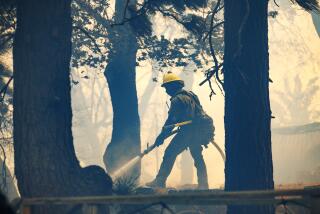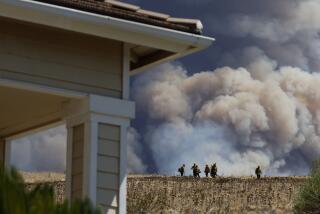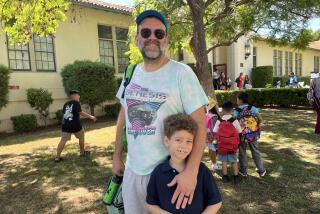Drawing on Their Feelings : Young Students Use Art to Release Smoldering Anxieties About Firestorms
Andrew Blackwood, 8, drew himself as a tiny “x” next to larger-than-life, monstrous fire. He painted the fire in charcoal black with such slashing, furious strokes that the watercolor bled through to the other side of the white paper.
Andrew put an open mouth on his “x” figure, the finishing touch on his portrait of fear during the Altadena firestorm. “I’m yelling,” he explained solemnly. “I’m mad. Because the guy lighted the fire, and he didn’t put it out.”
“That’s how I felt too,” said Pasadena artist Kimball Barton, 32, peering over Andrew’s shoulder at Arthur Amos Noyes Elementary School. “I felt like I was in a little corner and didn’t know what to do.”
Andrew nodded. Though his family and house survived the fire safely, his art conveyed the lingering anxiety his vocabulary perhaps could not.
Andrew’s third-grade class was part of an arts recovery program for students in the Pasadena Unified School District, sponsored by the city of Pasadena’s Arts Division.
In November, local artists began visiting every classroom in the four district schools that were evacuated after the Altadena wildfire: Don Benito, Loma Alta, Noyes and Sierra Madre elementary schools.
Art Rooms of Expression II is the second such program run by the city’s Art Division, said director Denise Nelson Nash. The first arts recovery program, which followed last year’s Los Angeles riots, proved so successful in helping students air their feelings and release their anxieties, that city officials decided to organize another effort.
After the fires, district psychologists also visited the schools, offering individual and group counseling. They also gave tips to principals and teachers on how to help children cope with the trauma, including a list of signs of stress, said district psychologist Judi Barhydt. Signs include repeated nightmares about the fires, unusual behavior, such as aggression or withdrawal, and intense emotional reaction to reminders such as sirens, the smell of smoke, or the sight of cloudy mountains. For instance, teachers said recent blustery winds triggered memories and fears of the fires in their students.
The art is one way for students to face those fears.
“It’s down there (on paper) and distanced from them,” Barhydt said. “It gives them a sense of mastery.”
Sometimes, she said, children who notice that their parents grow anxious at talk of the fires avoid the subject. On the other hand, some parents see no reason to ask their children what they think, preferring to put the fires behind them.
“A lot of people say, ‘(The kids) seem OK. They sleep at night. They don’t bring it up,’ ” Barhydt said, adding that parents should discuss their thoughts and acknowledge their fears and sense of loss with their children.
Barhydt flipped through artwork from one school. One third-grade girl drew a controlled picture of a ridge of mountains, with flickers of orange flames at the top. Below, she drew her house and family car. She drew herself carrying a box of pictures to the car, far away from the flames. No tears, no chaos.
“It means she’s been able to put that in perspective and have mastery over what happened,” Barhydt suggested.
Another third-grade boy used bold blacks and reds to create a picture full of activity--fires raging out of control, news helicopters flying overhead, a firetruck racing up a road, an engulfed house leaning precariously.
“This is just chaotic,” she said, but stressed that such a picture does not necessarily indicate that a child is troubled or needs counseling.
At Sierra Madre school, in one class of second- and third-graders, most students jumped out of their seats, waving their hands in the air to get the attention of Altadena artist George Combs.
“My uncle, he helped put out the fire,” one girl said.
“I saw a helicopter fall,” another student said.
“My dad works for Sierra Madre police, and he was in charge of the fire,” a boy said.
But in the back, 8-year-old Tamika Dixon slowly raised her hand.
“Can we draw something else instead of fire?” she pleaded.
Combs, 47, told her to draw whatever was on her mind. Later, Tamika said she didn’t want to talk about the fire anymore because it made her sad.
“When people’s houses burn down, they cry,” the third-grader said. “They lose their house, and they go away, and don’t have friends anymore.”
She ended up drawing a picture of the fire in her neighborhood anyway.
In Tamika’s class, third-grader Seth Chapman, 8, used crayon and pencil to draw a wall of smoke near his rendering of the homeless man who allegedly set the Altadena blaze in an effort to keep warm. The man is standing on a green hillside, saying “Help.”
Seth grabbed his blue crayon to add a little more sky.
“Just a bit,” he muttered to himself, “ ‘cause that dumb fire’s messing it up. Clogging the beautiful air in Sierra Madre. You stupid fire!”
Later, Seth said the drawing helped him to understand his feelings. He learned: “Don’t be afraid of it. You have to learn to live with it.”
At Noyes, third-grader Matthew Spencer penciled himself as a pilot, nosing a water-dropping helicopter into the heart of the flaming mountains.
“I wish I was a helicopter pilot,” said Matthew, 8, “because I wish I could save people from the fire.”
Sierra Madre third-grader Baird Marble’s crayon renderings filled the entire page, mostly in bold blacks and reds, smoke and fire engulfing mountains and a house.
His house was five miles away from the Altadena fire. Baird was scared for people in the Malibu fire, too, especially when he heard it was set by an arsonist.
“I’ve been wondering why are these people doing this,” Baird said. “It’s like I try to think, stop the fire, STOP THE FIRE. But it keeps on coming back to my mind.”
More to Read
Sign up for Essential California
The most important California stories and recommendations in your inbox every morning.
You may occasionally receive promotional content from the Los Angeles Times.










